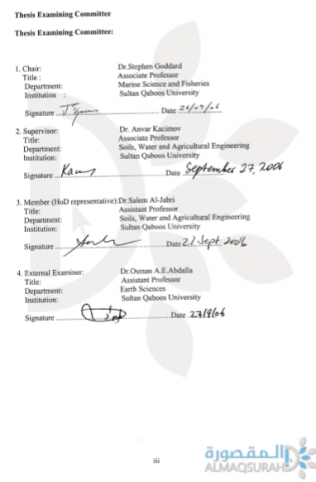
Springs were the main water source before the 1970s for Salalah city and the people who stay in the Dhofar Mountain chain. People after the development of the country are mainly depending on ground water extracted. However, the springs play an important role for providing water for domestic, livestock and agricultural uses. Most of these springs are located in foothills of label Al-Qara and classified as karst springs. The objective of this study is to identify the hydrologic and hydro-geologic response of Garsias and Arzat spring catchments after rainfall events. Garsias and Arzat springs are located at the elevation of 106, 104 mamsl (meters above mean sea level) respectively. In addition, there are other three major springs: Sahalnawt, Hamran, and Tobruk in the foothills of label AI-Qara. Application of linear potential theory (LPT) to study the Garsias and Arzat springs through the analytical solution by use of Mathematica Software shows that there are no quasi-horizontal flow stream lines and no quasi-vertical potential velocity. The recession curve coefficient of both springs varies between 0.020 to 0.665 l/month for Garsias and 0.0099 to 0.1649 lImonth for Arzat spring. The analysis of the Garsias and Arzat springs shows that the observed recession curve gives better fit by use of the Maillet formula compared with the Boussinesq formula. This study estimates the hydraulic properties and characteristics of label AI-Qara aquifers (study area), for example, hydraulic conductivity, and hydraulic head. The ratio of new water is nearly 20 % of total water that arrives at the spring outlet. Flow type is considered a rapid flow based on the recession curve, whereas using chemical analysis (new water ratio) is diffuse flow. We estimated the total direct recharge of water during the monsoon that reaches the water table between 18.0 to 67.60 % of the total rainfall in label AI-Qara. The monsoon supplies only 29.91 to 45.76 % of the total water discharge from the springs during one hydrologic year. In addition, we calculated the hydraulic conductivity in Garsias catchments and the results show that it varies between 0.022 to 0.209 m/day using actual observation well data. Whereas by using mathematical model it varies between 0.212 to 7.056 m/day. The results of the statistical analysis (autocorrelation and crosscorrelations) show no significant relation between the discharge rate and rainfall after two month. The annual discharge rates and annual precipitation calculated by Mathematica software are 1.12xl06 m'zyear, 345.27 mm / year for Garsias spring and 6.14 xl 06 m3/year, and 204.44 rom /year for Arzat spring. Generally, spring is a unique source of information for the water assessment in the region. The study of springs leads to further investigation of the label AI-Qara aquifers
Springs were the main water source before the 1970s for Salalah city and the people who stay in the Dhofar Mountain chain. People after the development of the country are mainly depending on ground water extracted. However, the springs play an important role for providing water for domestic, livesto...